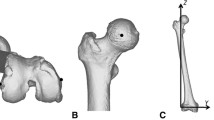Abstract
Background
The canal flare index (CFI; the ratio of the diameter of the femoral canal at the isthmus in the anteroposterior (A–P) view to the diameter of the medullary canal 20 mm above the lesser trochanter) is often used as a canal characteristic. Clinically, however, CFI measurements are sometimes untrustworthy because of femoral rotation and, especially, greater anteversion among Japanese patients. Our objectives were to analyze femoral geometry, by use of 3D CAD models, to evaluate the effects of rotational error, and to seek an index less affected by rotation.
Methods
Computed axial tomography (CAT) scan data from 60 femurs were used. By use of CAD software, 3D femoral models were created. The outside of the femur and the inside canal width 20 mm (P20) and 10 mm proximal (P10), and 10 mm (D10), 20 mm (D20), 30 mm (D30), and 40 mm (D40) distal from the center of the lesser trochanter, and at the isthmus were measured for different angles of femoral rotation. CFI, FFI (femoral flare index; the ratio of the extra-cortical diameters at the same levels as for the CFI), and other canal ratios (P20/D10, P20/D20, P20/D30, and P20/D40) were then calculated and the effect of rotational errors was investigated.
Results
Mean CFI, FFI, P20/D10, P20/D20, P20/D30, and P20/D40 were 4.29, 2.08, 2.05, 2.49, 2.85, and 3.09 in the position without rotational error. CFI was not related to anteversion but had a negative correlation with isthmus canal width (only). In contrast FFI was almost constant at approximately 2.1 for different anteversion and age. With regard to the effect of rotational error, CFI changed by 1.31, FFI by 0.40, P20/D10 by 0.41, P20/D20 by 0.40, P20/D30 by 0.59, and P20/D40 by 0.80 for a variety of rotational angles.
Conclusions
Outside femoral shape was little different for any person; as a result, FFI was almost constant. In contrast, CFI was revealed to be affected by canal width at the isthmus only. With regard to the effect of rotation, P20/D20 was much less affected by rotation than CFI; it could, therefore, be an appropriate index for expressing proximal canal shape.






Similar content being viewed by others
References
Walker PS, Culligan SG, Hua J, Muirhead-Allwood SK, Bentley G. Stability and bone preservation in custom designed revision hip stems. Clin Orthop Relat Res. 2000;373:164–73.
Leali A, Fetto J. Promising mid-term results of total hip arthroplasties using an uncemented lateral-flare sthip prosthesis: a clinical and radiographic study. Int Orthop. 2007;31:845–9.
Noble PC, Alexander JW, Lindahl LJ, Yew DT, Granberry WM, Tullos HS. The anatomic basis of femoral component design. Clin Orthop Relat Res. 1988;235:148–65.
Rubin PJ, Leyvraz PF, Aubaniac JM, Argenson JN, Estève P, de Roguin B. The morphology of the proximal femur. A three-dimensional radiographic analysis. J Bone Joint Surg Br. 1992;74:28–32.
Clohisy JC, Nunley RM, Carlisle JC, Schoenecker PL. Incidence and characteristics of femoral deformities in the dysplastic hip. Clin Orthop Relat Res. 2009;467:128–34.
Bartko JJ. The interclass correlation coefficient as a measure of reliability. Psychol Rep. 1966;19:3–11.
Landis JR, Koch G. The measurement of observer agreement for categorical data. Biometrics. 1977;33:159–74.
Khang G, Choi K, Kim CS, Yang JS, Bae TS. A study of Korean femoral geometry. Clin Orthop Relat Res. 2003;406:116–22.
Hirade T, Kawanishi T, Iguchi H. Congruity of lateral flare stem with the proximal lateral cortex of the femur. Nihon Jinkoukansetsu Gakkai Zasshi. 2008;38:568–9 (in Japanese).
Eckrich SG, Noble PC, Tullos HS. Effect of rotation on the radiographic appearance of the femoral canal. J Arthroplasty. 1994;9:419–26.
Sariali E, Mouttet A, Pasquier G, Durante E, Catone Y. Accuracy of reconstruction of the hip using computerised three-dimensional pre-operative planning and a cementless modular neck. J Bone Joint Surg Br. 2009;91:333–40.
Husmann O, Rubin PJ, Leyvraz PF, de Roguin B, Argenson JN. Three-dimensional morphology of the proximal femur. J Arthroplasty. 1997;12:444–50.
Scuetz A. Multiple detector helical CT of the chest can reduce x-ray dose to 0.3 mGy. 85th Scientific Assembly and Annual Meeting. November 28 to December 3. Chicago: McCormick Place; 1999.
Fuku H. Cementless hip prosthesis design: a basic study and analysis of the proximal femur in normal Japanese people. Nihon Seikeigeka Gakkai Zasshi. 1994;68:763 (in Japanese).
Hagiwara M. Morphological analysis of the proximal femur by computed tomography in Japanese subjects. Nihon Seikeigeka Gakkai Zasshi in Japanese. 1995;69:1147 (in Japanese).
Noble PC, Box GG, Kamaric E, Fink MJ, Alexander JW, Tullos HS. The effect of aging on the shape of the proximal femur. Clin Orthop Relat Res. 1995;316:31–44.
Ruff CB, Hayes WC. Subperiosteal expansion and cortical remodeling of the human femur and tibia with aging. Science. 1982;217:945–8.
Smith RW Jr, Walker RR. Femoral expansion in aging women: implications for osteoporosis and fractures. Science. 1964;145:156–7.
Xu H, Zhou Y, Liu Q, Tang Q, Yin J. Femoral morphologic differences in subtypes of high developmental dislocation of the hip. Clin Orthop Relat Res. 2010;468:3371–6.
Iguch H. The concepts of lateral flare stem aimed to store the bone stock and 12 years results. Nihon Jinkoukannsetsu Gakkai Zasshi. 2008;38:110–1 (in Japanese).
Conflict of interest
The authors declare that they have no conflict of interest.
Author information
Authors and Affiliations
Corresponding author
About this article
Cite this article
Tawada, K., Iguchi, H., Tanaka, N. et al. Is the canal flare index a reliable means of estimation of canal shape? Measurement of proximal femoral geometry by use of 3D models of the femur. J Orthop Sci 20, 498–506 (2015). https://doi.org/10.1007/s00776-015-0704-x
Received:
Accepted:
Published:
Issue Date:
DOI: https://doi.org/10.1007/s00776-015-0704-x




